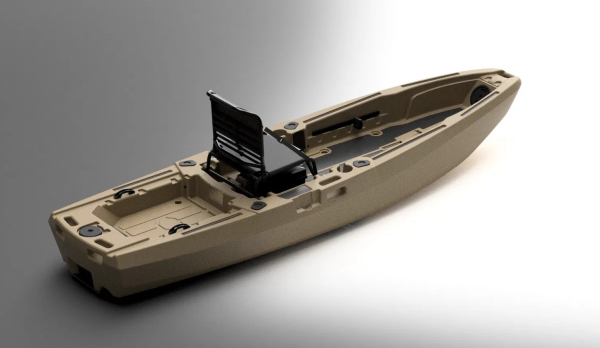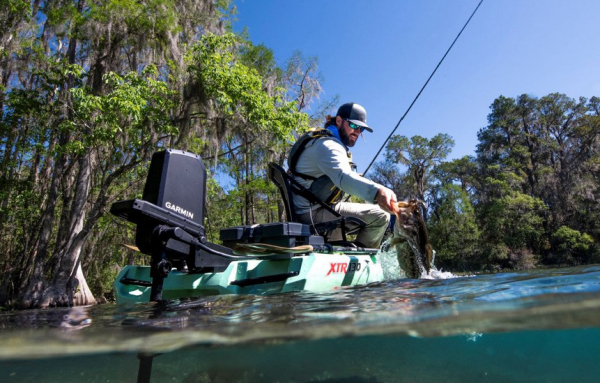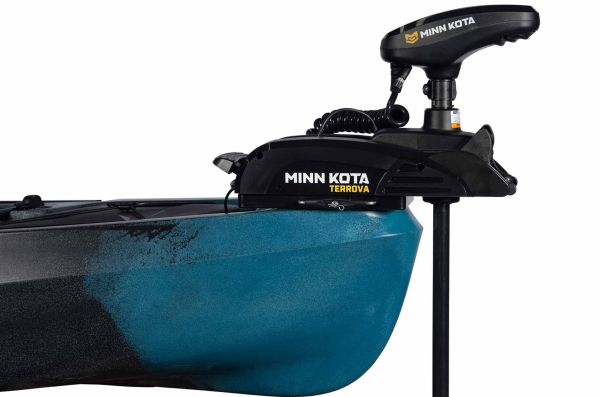
When it comes to inventions in the “why didn’t I think of that” category, the new Kymera Electric Jet Fishing Kayak—newly famous for winning not only Best of Category but also Best of Show title at last week’s ICAST –takes the prize.
Water jets are not new, of course—every PWC on the water uses them, and they’re also made in larger sizes all the way up to yacht class like the massive jets made by Hamilton, which can handle up to 1200 horsepower. On the lower end of the scale, e-foiling jet-powered surfboards have become popular water-toys in some areas.
But as far as we can discover, the 11-foot Kymera is the first to combine an electric jet motor with a ‘yak in a very compact installation that can run in water barely deep enough to float a bluegill. (The company has been making electric jet powered body boards for some time, but this is their first kayak.)
The 12’ yak weighs only 88 pounds including the jet motor—but not including the battery, which can be any standard 12-volt. Most who invest in the ‘yak will probably also want a lightweight lithium-metal battery to go with it, another $900 to $1200, but if you want to save money and haul the weight, a standard 105 amp-hour deep cycle lead acid will work fine, too, for about $100 bucks. Top speed is reportedly 5 mph, while at more moderate speeds run time is up to 960 minutes per the company.
The huge advantage the jet system has is that it runs flush with the bottom of the ‘yak, which means you can power across water that’s maybe 6” deep, impossible with any conventional propeller-type power. The motor steers with a small side lever mounted where the operator’s hand naturally meets the gunwale, and the boat can turn in its own length at low speed.
Of course, the big caveat with this or any water-jet system is that you can’t operate them where thick weeds blanket the surface because they will jam. But the company has videos showing the Kymera motoring through some fairly weedy water without issue, so this may not be a huge problem unless you get into really heavy floating cover.
The motor is a bit noisy at speed, too, as with most jets, and the steering is typically rather random per the company video, but since you’re only going at walking speed or thereabouts, corrections are not an issue.
An important feature, missing on most yaks, is that navigation lights are built in. Operating yaks without lights early and late is very dangerous due to the low profile and the risk of other powerboats not seeing you, so even though nav lights are not required on paddle-craft in most states, this is an important feature.
Garmin’s Force Current

In this same genre is Garmin’s new electric trolling motor designed specifically for kayaks, the Force Current, which was voted Best Motorized Boat Accessory at ICAST . The stern-mount motor allows anglers to wirelessly fish and maneuver at the same time.
Power steer pedals allow the user to steer without hands, as well as access key features like anchor lock and heading hold. The anchor lock feature is particularly important for anglers structure fishing, where you might want to sit on a spot despite wind and current while you make multiple casts to a school of fish.
Wireless throttle and steering can be accomplished with the foot pedals, handheld remote or compatible smartwatch. The motor runs in both freshwater and saltwater. It’s $3,599.99 with foot pedals, $2,999.99 without. It produces 30 pounds of thrust on a single 12-volt, or 50 pounds on 24 volts, per the company. The motor weighs 25 pounds; https://www.garmin.com.
Minn Kota Terrova

It produces 55 pounds of thrust on a 12-volt battery, has a 36” shaft, is controlled by a micro-remote and includes that all important Spot Lock as well.
The motor is designed to fit pre-drilled mounting holes on some Old Town yak models, and the company says installation only takes about 30 minutes for most buyers.
It’s about $1,300; https://minnkota.johnsonoutdoors.com.
— Frank Sargeant
Frankmako1@gmail.com